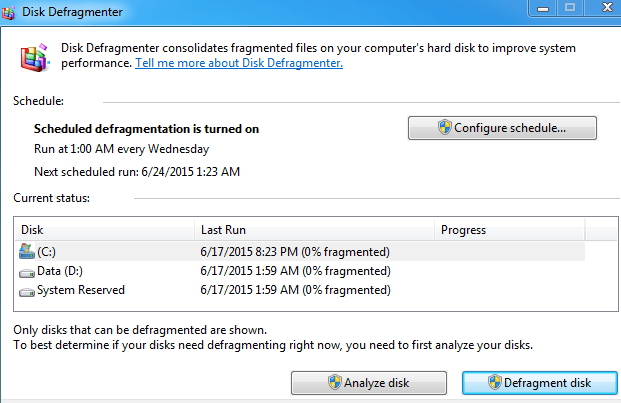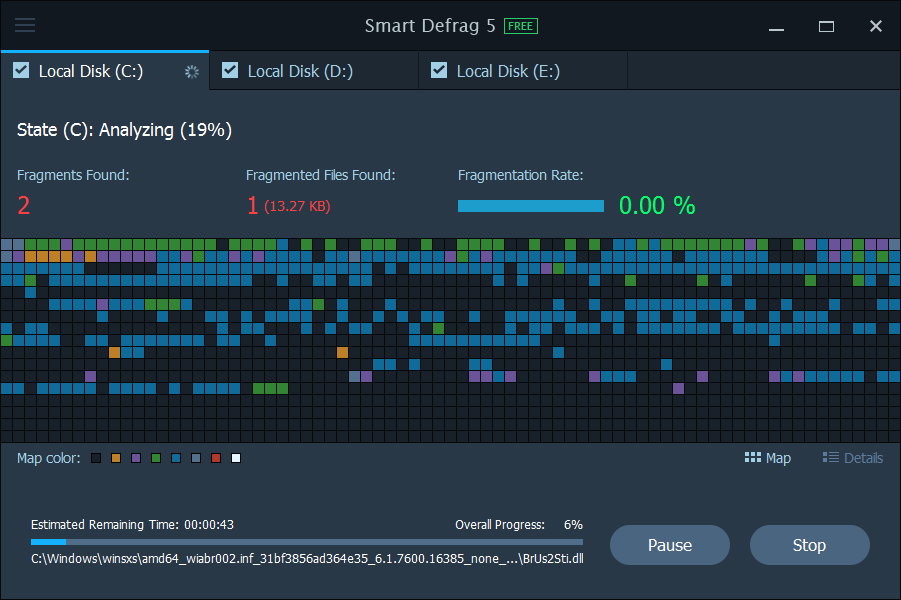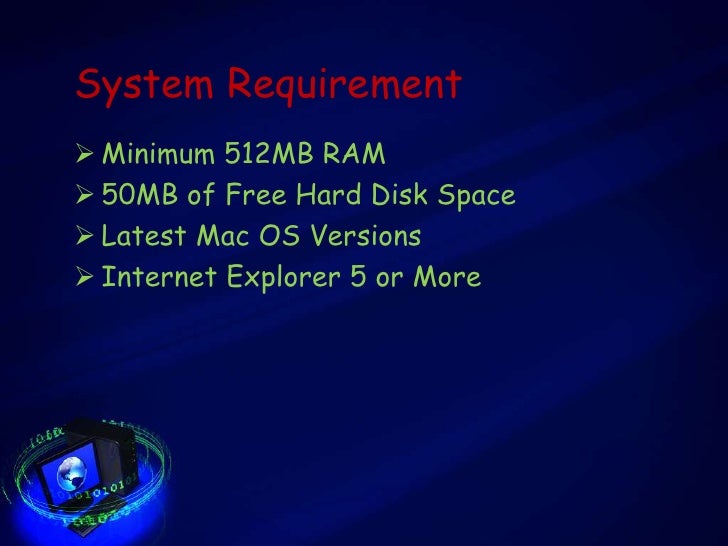Free Defrag For Mac Os
Delivering speedy and smooth performance, Macs are known to be fast and reliable. However, despite being considered close to computer perfection, Macs are not immune to slow-downs. Bogged down performance can be caused by a number of reasons. These include scattered empty clusters on the hard disk that had appeared as a result of multiple reads and writes performed. To deal with the issue on Windows OS, you would have to defragment your HDD, but can you defrag a Mac?
Does Defragmentation for Mac Work?

For Mac OS defragment disk, you can rely on iDefrag to work efficiently. It is a useful tool to defrag and optimize your computer. You just have to reboot your computer and the software will provide you options to defrag the system. May 06, 2021 How to defrag a Mac. If all options above have failed to free up the space you need and you still want Mac defragmentation, here’s how to defrag a Mac and what you need to do so. Step 1: The safest and easiest way to do a defrag for a Mac is to use trusted third-party Mac defrag software.
It’s no secret that macOS is different from Windows. Among other things, they differ in the way they approach writing files on disk. Windows breaks up all files when writing them into clusters, while OS X does not fragment the small ones. As a result, there is no need for defragging them.
On one hand, this eliminates the need for regular defragmentation. On the other hand, once in every few years defragmentation is still needed due to app installs, big updates and flow of other large files on your Mac HDD.

Things to Know Before Defragging a Mac

In order for you to keep the hard drive running at its top speed, it is recommended to keep your data on the first 50% of the drive. HDDs operate faster in the first half due to having more sectors on the track with less travel time taking the heads to reach them. Running a defraggler helps contain maximum of your files on the first 50% of the drive which results in it performing faster.
Defrag also provides a solution to some of the more serious hard drive performance issues like failing sectors on the drive. It is worth mentioning that it will not repair physically damaged sectors, but only solve the soft bad sector errors.
Defragmenting Hard Drive on Mac
Fully defragmenting your HDD is a fairly complicated thing to do on a Mac, though don’t let it stop you from doing so in the first place. After all, this should be done only once every few years and reclaimed drive performance will definitely be worth it.
Defragging on the Live System
Let’s get it straight, defragmenting your drive will require a third-party application as Apple does not provide any native defrag tools.
Hands down, running defrag software on live system is the quicker way of getting it done. It is the one that’s riskier too. The drill is, no matter how good the software is, you always run the risk of something not going as intended, and if it does — you’re stuck. At this point, making backups just goes without saying.
Essentially, to defragment your Mac’s hard drive you will have to:

- Find and download a reliable third-party defragmentation software
- Review all of your files and take out the Trash (ideally try to stay within 50% of your total HDD capacity)
- Run a trusted cleaning app to get rid of outdated and corrupted support data
- Make a backup of your data in cloud or external drive
- Run the software of your choice and follow the onscreen instructions
It’s also worth noting that this method does not guarantee that you will defrag your disk in its entirety.
Defrag Using External Clone
Those of you who are willing to take the high road and invest more time towards achieving reliable results, will favor this approach.
Instead of trying to defrag a disk from within the system itself, this method will have you create a clone of your current HDD, wipe the slate clean, and import things back, yet this time in the right order fitting all the clusters.
To make it happen:
- Remove outdated and unneeded files from your hard drive (try to fit all of your data in under 50% of total drive capacity)
- Scan and Clean your system of redundant leftover application data
- Find and download a trusted drive cloning software
- Create an identical clone of your boot partition (Macintosh HD) on an external drive formatted as OS X Extended Journaled
- Reboot your Mac holding down the Option Key and boot from the clone drive using Startup Manager.
- Test out the clone to make sure it operates correctly
- Using Disk Utility fully erase data on Macintosh HD
- Get back to the cloning software and reverse clone all of your data back to the main boot HDD
This may take significantly longer, however, it is worth the time spent to confirm your hard drive working to the best of its ability.
Can You Defrag a Mac SSD?
The introduction of solid state drives has brought in significant improvements in read and write speeds. There is no surprise in Apple making a move to swap out HDDs for SSDs in their computers. Besides improved read & write speeds, SSDs feature trim commands which inform the OS how to treat blocks of data and when to wipe it internally. In other words, TRIM provides built-in self-maintenance processes that do make a world of difference as they nullify the need for defragmentation.
Moreover, defragging an SSD does it more harm than good. Solid state drives operate differently from a traditional hard disk and have limited erase cycles. Defragmentation attempts to reallocate data and puts your drive through multiple reads and writes. Because SSDs feature their own maintenance scripts, attempting to defrag your drive will only reduce its lifespan.
To draw the line, defragmentation will only benefit your Mac if it’s still got a hard drive in its heart. Running the full cycle every couple of years will help squeeze out more performance out of your HDD. On the contrary, defragging an SSD will show no positive result and only hurt its longevity.
How long does it take your computer to solve different tasks? Sooner or later, every PC user wonders what they have to do to speed up the routine processes and improve its overall performance. When you ask a professional what moves can you make, there’s every likelihood that he will name the disk defragmentation.
What Is Disk Defragmentation After All?
Let’s stop here for a moment and explain what defragmentation is. Not every Mac user is aware of this process, which reminds of the apartment cleaning when people fit things into their places and get rid of junk along the way. The thing is, while being written to the disk, a file usually gets fragmented – divided into pieces to fit in the available free space. Later on, the data may be modified many times and/or moved from one folder to another.
Over time, almost each computer suffers from the increasing fragmentation, which makes the system spend more time looking for separate pieces of the file in various areas of the disk. That’s why the need to rearrange data and clean some space appears. The core idea of defragmentation is that the pieces of information scattered on your hard drive are brought back together. Done right, it may help to fix many issues on your favorite computer.
Disk Defragmentation Mac
Luckily, the users don’t have to defragment their drives manually any longer.
What Is Defragging Regarding Apple Computers?
OK, now you have the basic idea of what defragging means and why it needs to be done from time to time. In a nutshell, if you ask yourself “Why does my hard drive take longer to read certain files?”, think about defragmentation. It will put the block back in sequential order. The drive head will stop running around the whole platter to read just one file.
Some people believe there is no need to defrag HDD on Mac. Also, they often add that you can’t use this procedure on SSD (solid-state drive) because it may be harmful to it. Although these assertions are partly correct, it is still important to discuss what defragging is regarding Mac before making conclusions.
Unlike Microsoft, Apple uses another file system on their computers called HFS+. It provides a special function called Hot File Adaptive Clustering (a.k.a. HFC). The main purpose of this component is to prevent fragmentation of disk storage automatically. Defragmentation may be necessary in case a relatively old drive is installed in the machine. If the hard disk is occupied for a long time by the large multimedia files (more than 1GB), defragmentation is a solution. Such data is highly susceptible to fragmentation. Thus, it can be difficult to automatically avoid it.
On the other hand, not so many users still have old drives. That’s why you can’t find defragmentation tools among Apple’s onboard utilities. In case you believe optimization is necessary, mind some smart solutions from third-party companies (e.g., iDefrag). The good thing is you should not run the process manually: it happens automatically on OS X. Once your Mac’s ‘house’ is full, let the smart defragging app solve the issue.
Does Defragmentation Make Sense on Macs?
While most experts would call Mac’s defragmentation an optional activity, let’s talk about the exceptions. The application of this procedure may bring several benefits. Are you a multimedia developer with tons of large files? Then you will almost inevitably face file fragmentation issues, which will make you wonder how to manage thousands of 1GB video/audio items. Remember, that such applications as Adobe Premier and Photoshop tend to produce files of enormous size.
If you do have old, overloaded HDD (where, say, hundreds of 10GB files are stored), try defragmentation. A good third-party tool that really works for this purpose is iDefrag, which costs around $32. Please, note that before running defragmentation, it is highly advisable to back up the drive to keep your data safe.
Remember that defragmentation has nothing to do with compression or destruction of files. The physical storage blocks will be reorganized. The specific algorithms depend on the selected defragging app, so you might want to learn more details before choosing the application. The positive outcomes of defragmentation include:

- Shorter response time of data saved on your computer
- Faster performance of all apps
- Enhanced hard drive’s efficiency.
What about the negative consequences? As far as we are acknowledged, OS X defrag has no negative outcomes for your HDD.
How to Defrag HDD Step-by-Step
Let’s say you decided to use a specialized third-party tool to defrag your Mac. Back up your data not to lose it – it is critical to be able to restore necessary files in case something goes wrong. To rest assured, apart from Apple’s built-in Time Machine, turn to good old storages like Dropbox to protect your data from the potential threat. Then, select the most suitable utility and download it. Make sure the chosen software is compatible with your version of OS. Follow these instructions to defrag your hard drive on Mac safely.
• Thin out user files on the boot drive. Start with the largest files like videos. Mind that a full boot drive (more than 80% filled) won’t let your computer function at its best. Thus, you will have to sacrifice some files or store them elsewhere.
In case you count on the best performance, decrease the files’ size so that the boot drive is less than 50% filled.
• Choose a blank powered external drive. A Carbon Copy Cloner will help to clone the OS X boot partition (Mac hard disk) to the external drive.
• Reboot your device. Boot from the clone with the help of Startup Manager. If you happen to have some doubts, examine the clone for a while.
Make sure it is reliable and try to notice any undefined problems at this stage.
• Go to Disk Utility -> Security. Use “Zero” option to erase the internal Mac HD or the entire drive. Get rid of the bad sectors during the process.
Never move the machine during this procedure!
• Reverse clone once you’re finished. Launch Disk Utility and choose Repair Permissions on OnyX maintenance and cleaning aspects. Reboot the computer.
This process helps to cope with several issues:
- Corrupt caches
- Optimization problems
- Defragmentation problems
- Obstacles created by bad sectors
- Overall safety
Users create clones to allow them solving the same problem later when news apps fill the space. The lack of RAM, as well as some other problems, can be the only obstacles on the way to proper fragmentation.
Should You Defrag SSD on Mac?
Everything said above concerns all Apple computers equipped with the hard disks with moving parts. The thing is, the majority of modern Macs has SSDs. Their structure and recommended care vary. Many people wonder what happens to SSDs after the attempt to defrag them. Any tech person would say that traditional defragmentation for SSD is not acceptable. SSD defragmentation can lead to the active block overwriting. Plus, it will reduce the disk’s lifespan as it has the limited number of write/overwrite cycles. In the worst-case scenario, performing such procedures on Mac may simply disable SSDs. On the whole, the work of SSDs reminds of the way RAM modules function. The speed of reading/writing from different blocks has nothing to do with the file location.Also, keep in mind that third-party defragmentation apps are not supported by Apple. These instruments should never be launched on SSD flash storage drives. Thus, we can conclude that you do not need to defrag SSD as it makes no sense.
Will Defragmenting Speed up Computer and What Are Some Other Alternatives?
Are you tired of your Mac being as slow as a snail? Several methods exist to improve your device’s performance. A defragmentation may be a great option for older Macs, but as we’ve clarified, it does not always help or is actually needed to optimize the new device. Here’s the short list of other steps you can take to speed up your struggling Mac:
- Shut down running applications to have more free space. Keep in mind that the majority of slowdowns happens because of the RAM constraints. Another reason may be the more intense use of virtual memory.
- Update software on a regular basis.
- Clean your Mac from garbage files (temporary, duplicates, caches, etc.).
- Limit the number of apps that launch on startup without your permission.
- Reboot your Mac every time you want to free up memory and setup system updates.
- Remember that the latest OS X versions allow performing better as well as fixing bugs.
- Check whether there is a minimum of 10-20% of free space on the hard drive at all times.
- Apply “Verify Disk” function to detect a failing drive.
Free Defrag For Mac Os Download
This way, you can speed up your Mac as well as eliminate several other gaps.
Free Defrag For Mac Os 11
Write us info@defragmac.com | Find us at the office 2500 W Bradley Pl, Chicago, IL 60618 | Give us a ring +1 (773) 891-5400 | Our partner Essay Writer Service |